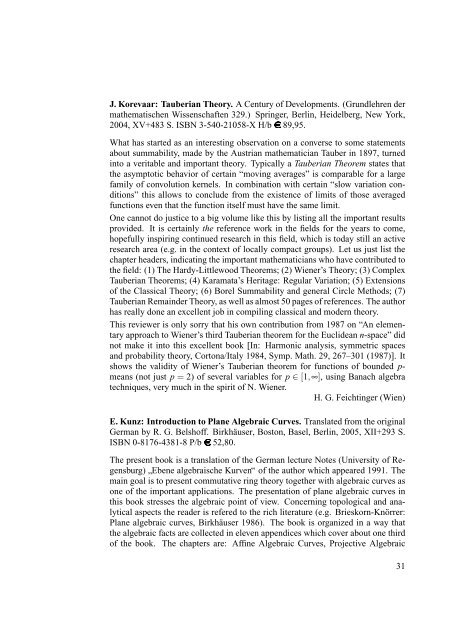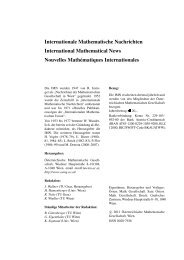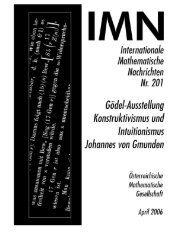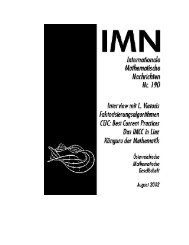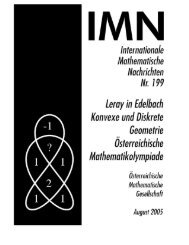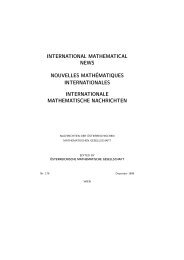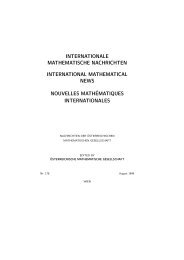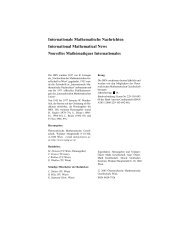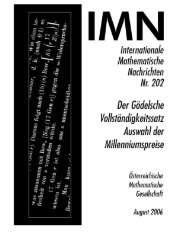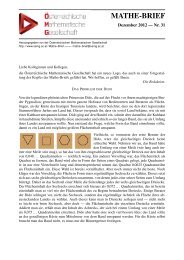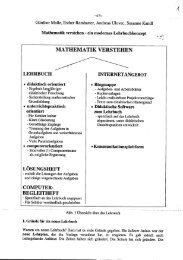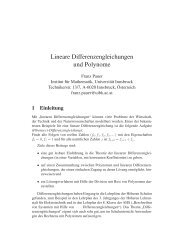203 - Ãsterreichische Mathematische Gesellschaft
203 - Ãsterreichische Mathematische Gesellschaft
203 - Ãsterreichische Mathematische Gesellschaft
Erfolgreiche ePaper selbst erstellen
Machen Sie aus Ihren PDF Publikationen ein blätterbares Flipbook mit unserer einzigartigen Google optimierten e-Paper Software.
J. Korevaar: Tauberian Theory. A Century of Developments. (Grundlehren der<br />
mathematischen Wissenschaften 329.) Springer, Berlin, Heidelberg, New York,<br />
2004, XV+483 S. ISBN 3-540-21058-X H/b 89,95.<br />
What has started as an interesting observation on a converse to some statements<br />
about summability, made by the Austrian mathematician Tauber in 1897, turned<br />
into a veritable and important theory. Typically a Tauberian Theorem states that<br />
the asymptotic behavior of certain “moving averages” is comparable for a large<br />
family of convolution kernels. In combination with certain “slow variation conditions”<br />
this allows to conclude from the existence of limits of those averaged<br />
functions even that the function itself must have the same limit.<br />
One cannot do justice to a big volume like this by listing all the important results<br />
provided. It is certainly the reference work in the fields for the years to come,<br />
hopefully inspiring continued research in this field, which is today still an active<br />
research area (e.g. in the context of locally compact groups). Let us just list the<br />
chapter headers, indicating the important mathematicians who have contributed to<br />
the field: (1) The Hardy-Littlewood Theorems; (2) Wiener’s Theory; (3) Complex<br />
Tauberian Theorems; (4) Karamata’s Heritage: Regular Variation; (5) Extensions<br />
of the Classical Theory; (6) Borel Summability and general Circle Methods; (7)<br />
Tauberian Remainder Theory, as well as almost 50 pages of references. The author<br />
has really done an excellent job in compiling classical and modern theory.<br />
This reviewer is only sorry that his own contribution from 1987 on “An elementary<br />
approach to Wiener’s third Tauberian theorem for the Euclidean n-space” did<br />
not make it into this excellent book [In: Harmonic analysis, symmetric spaces<br />
and probability theory, Cortona/Italy 1984, Symp. Math. 29, 267–301 (1987)]. It<br />
shows the validity of Wiener’s Tauberian theorem for functions of bounded p-<br />
means (not just p = 2) of several variables for p ∈ [1,∞], using Banach algebra<br />
techniques, very much in the spirit of N. Wiener.<br />
H. G. Feichtinger (Wien)<br />
E. Kunz: Introduction to Plane Algebraic Curves. Translated from the original<br />
German by R. G. Belshoff. Birkhäuser, Boston, Basel, Berlin, 2005, XII+293 S.<br />
ISBN 0-8176-4381-8 P/b 52,80.<br />
The present book is a translation of the German lecture Notes (University of Regensburg)<br />
”<br />
Ebene algebraische Kurven“ of the author which appeared 1991. The<br />
main goal is to present commutative ring theory together with algebraic curves as<br />
one of the important applications. The presentation of plane algebraic curves in<br />
this book stresses the algebraic point of view. Concerning topological and analytical<br />
aspects the reader is refered to the rich literature (e.g. Brieskorn-Knörrer:<br />
Plane algebraic curves, Birkhäuser 1986). The book is organized in a way that<br />
the algebraic facts are collected in eleven appendices which cover about one third<br />
of the book. The chapters are: Affine Algebraic Curves, Projective Algebraic<br />
31


